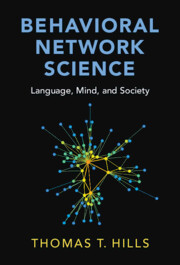Book contents
- Frontmatter
- Contents
- Additional Resources
- Introduction: Structure Matters
- Part I A Brief Guide to Network Science
- Part II Language
- Part III Mind
- 10 False Memories: Spreading Activation in Memory Networks
- 11 Cognitive Foraging: Exploration versus Exploitation
- 12 Age-Related Cognitive Decline: A Network Enrichment Account
- 13 Creativity: How Noisy Processes Create Novel Structure
- Part IV Society
- References
- Index
11 - Cognitive Foraging: Exploration versus Exploitation
from Part III - Mind
Published online by Cambridge University Press: 08 November 2024
- Frontmatter
- Contents
- Additional Resources
- Introduction: Structure Matters
- Part I A Brief Guide to Network Science
- Part II Language
- Part III Mind
- 10 False Memories: Spreading Activation in Memory Networks
- 11 Cognitive Foraging: Exploration versus Exploitation
- 12 Age-Related Cognitive Decline: A Network Enrichment Account
- 13 Creativity: How Noisy Processes Create Novel Structure
- Part IV Society
- References
- Index
Summary
Is searching memory like searching space? William James once wrote that “We make search in our memory for a forgotten idea, just as we rummage our house for a lost object.” Both space and memory have structure and we can use that structure to zero in on what we are looking for. In searching space, this is easy to see. A person hunting for their lost keys is not unlike a starling scouring the garden for wayward insects. But in searching memory, what is the map? And by what means does a person move from one memory to the next? In this chapter I will lay out the similarities between foraging in space and mind and then describe a research approach inspired by an ecological model of animal forging. Using this approach, we will combine data from a memory production task with a cognitive map – a network representation – of memory derived from natural language. We will then use this to compare a suite of models aimed at teasing apart how memory search is similar to our garden starling.
Keywords
Information
- Type
- Chapter
- Information
- Behavioral Network ScienceLanguage, Mind, and Society, pp. 161 - 183Publisher: Cambridge University PressPrint publication year: 2024
